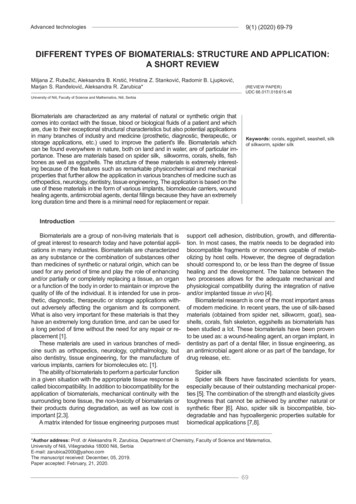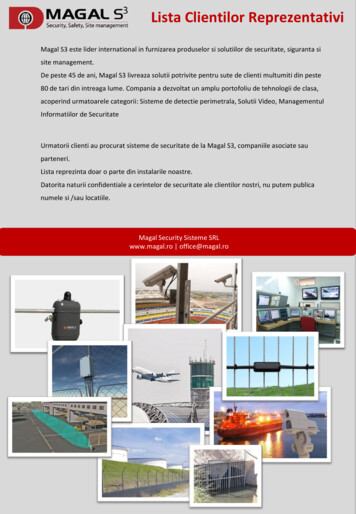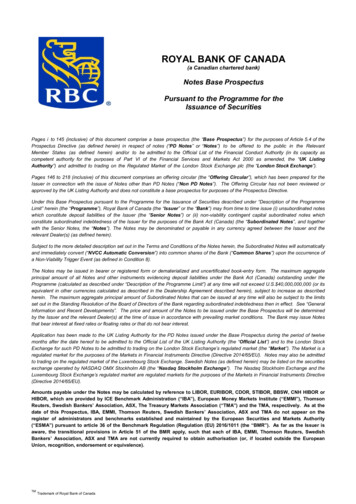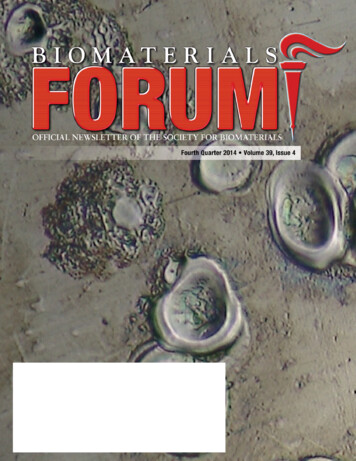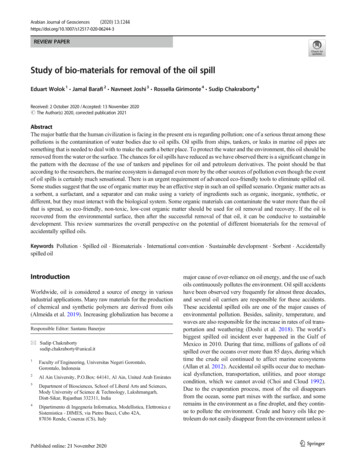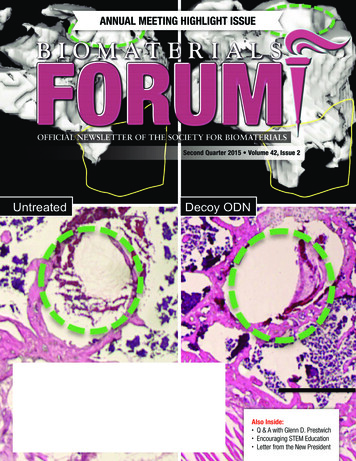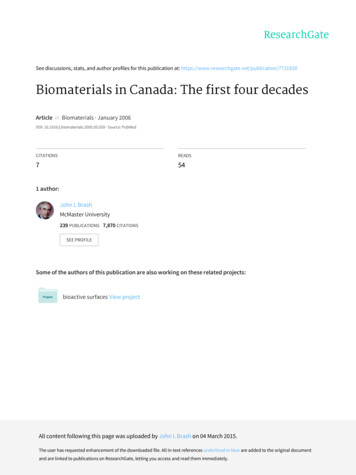
Transcription
See discussions, stats, and author profiles for this publication at: omaterials in Canada: The first four decadesArticle in Biomaterials · January 2006DOI: 10.1016/j.biomaterials.2005.05.039 · Source: PubMedCITATIONSREADS7541 author:John L BrashMcMaster University239 PUBLICATIONS 7,870 CITATIONSSEE PROFILESome of the authors of this publication are also working on these related projects:bioactive surfaces View projectAll content following this page was uploaded by John L Brash on 04 March 2015.The user has requested enhancement of the downloaded file. All in-text references underlined in blue are added to the original documentand are linked to publications on ResearchGate, letting you access and read them immediately.
ARTICLE IN PRESSBiomaterials 26 (2005) materials in Canada: The first four decadesJohn L. Brash School of Biomedical Engineering and Department of Chemical Engineering, McMaster University, 1280 Main Street West, Hamilton, Ontario,Canada L8S 4L7Available online 14 July 2005AbstractBiomaterials research in Canada began in the 1960s. Over the past four decades significant contributions have been made across abroad spectrum covering dental, orthopaedic, cardiovascular, neuro, and ocular biomaterials. Canadians have also been active inthe derivative area of tissue engineering. Biomaterials laboratories are now established in universities and research institutes fromcoast to coast, supported mainly by funding from the Federal and Provincial Governments. The Canadian Biomaterials Society wasformed in 1971 and has played an important role in the development of the field. The Society played host to the 5th WorldBiomaterials Congress in Toronto in 1996. The work of Canadian researchers over the past four decades is summarized briefly. It isconcluded that biomaterials and tissue engineering is a mature, strong area of research in Canada and appears set to continue assuch into the future.r 2005 Elsevier Ltd. All rights reserved.Keywords: Canada; Dental biomaterials; Orthopaedic biomaterials; Cardiovascular biomaterials; Neuro biomaterials; Ocular biomaterials; Researchfunding in Canada; Canadian Biomaterials Society1. OverviewCanada has had a presence in biomaterials sinceactivity in this field began in the 1960s, and before theterm was in general use. Over the past four decadesCanadian scientists and engineers have made keycontributions across the full spectrum of biomaterialsresearch, including dental, orthopaedic, cardiovascular,neuro, and ocular biomaterials. Canadians have alsobeen prominent in the related area of drug delivery andmore recently in the derivative area of tissue engineering. The research covered in this article is restricted tobiomaterials and tissue engineering. A brief account ofthis research over the past four decades is presented.Activity has been at locations, mainly universities,across the country though with much of it in Ontarioand Quebec, i.e. what is referred to as central Canada.The pioneering work of Dennis Smith and WalterZingg, discussed in detail below, led to the major effort Tel.: 1 905 525 9140x24946; fax: 1 905 521 1350.E-mail address: brashjl@mcmaster.ca.0142-9612/ - see front matter r 2005 Elsevier Ltd. All rights reserved.doi:10.1016/j.biomaterials.2005.05.039now ongoing at the University of Toronto. Of the 26researchers whose work is discussed in this article, 10 areor were in Toronto, and several others were trainedthere. Biomaterials work is ongoing in a number ofdepartments in both the medical and engineeringfaculties. A central focus is provided by the Instituteof Biomaterials and Biomedical Engineering. In all,Toronto is one of the world’s leading centres ofbiomaterials research. Another major centre in Ontariois at McMaster University in Hamilton. Activity hasalso developed over the last decade at Queen’sUniversity in Kingston, the University of Ottawa, andthe University of Western Ontario in London.In Quebec, the groups in Quebec City (l’UniversitéLaval) and Montreal (l’Ecole Polytechnique and McGillUniversity) have made many important contributionsand these universities are today among the leadingCanadian institutions doing biomaterials and tissueengineering research. The work at Laval is of longstanding and dates back to the 1970s. DalhousieUniversity in Halifax has had activity since the1970s also. This has recently been expanded with the
ARTICLE IN PRESS7210J.L. Brash / Biomaterials 26 (2005) 7209–7220establishment of the School of Biomedical Engineeringwhich has biomaterials as one of its focus areas. In theWest, work at the University of British Columbia,ongoing since the 1980s, and more recently at theUniversity of Alberta, is noteworthy. The researchachievements of the groups at all of these locations aredescribed in some detail below.It is always risky to pronounce judgement on specificresearch contributions. Such judgement clearly requiressome historical perspective, and in this respect it isprobably premature to judge more recent work. Fromthe perspective of 2005, the following may be cited asamong the major Canadian contributions: Polyacrylate bone cement and dental adhesives(Dennis Smith).Dental ceramics (Derek Jones).Porous metal coatings for joint prostheses (RobertPilliar).Bone–material interface interactions (John Davies).Blood–material interactions and blood compatiblematerials (John Brash, Michael Sefton).Live cell encapsulation using synthetic polymers(Michael Sefton).Implant-patient interactions via device retrievalstudies (Robert Guidoin).Contact guidance by topological micropatterning(Donald Brunette).The international stature of Canadian biomaterialsresearch has been recognized not only by the manypublications of Canadian scientists in high impactjournals, but also by the numerous awards received bythese scientists. As one example, the Clemson Awards ofthe Society for Biomaterials (USA) have been given tosix Canadian researchers. In addition a number of theprestigious Canada Research Chairs (CRCs) have beenawarded to biomaterials/tissue engineering investigators, and several of our number are Fellows of the RoyalSociety of Canada.As will be seen in the discussion below, biomaterialsresearch in Canada is currently strong with a significantnumber of investigators at the beginning or mid-phaseof their careers. The stage thus appears set for muchimportant work to be accomplished well into the future.2. The Canadian Biomaterials SocietyOn the initiative of Dennis Smith, Walter Zingg, andseveral others including Robert Jackson, Robert Salter,James Guillet, and Henry Garside, the CanadianBiomaterials Society was established in 1971. It is thusone of the first such societies in the world. The Societyhas held annual scientific and business meetings since1972. The scientific meetings have become known andvalued for their emphasis on student presentations andtheir informal ambience, with attendance typically in the100–150 range. This relatively small size is compatiblewith a single session meeting where participants areexposed to all aspects of biomaterials. This is of coursein contrast to the more typical larger scale meetings withtheir often ‘‘busy’’ atmosphere and multiple simultaneous sessions.A major accomplishment of the Society was thehosting of the 5th World Biomaterials Congress inToronto in 1996. Initially this was considered to be arisky undertaking for a relatively small group withlimited financial resources. In the event, it was a highlysuccessful meeting. Moreover a significant financialbenefit accrued to the Society, and this has beeninvaluable in furthering the Society’s goals. Torontoproved to be an excellent location, not least because ofthe high concentration of biomaterials activity in theOntario region.The Canadian Society has participated in the international cooperation initiatives among the BiomaterialsSocieties around the world. It was a member of theInternational Liaison Committee from its inception andis currently a member of the International Union ofSocieties for Biomaterials Science and Engineering.3. Funding of biomaterials research in CanadaThat biomaterials research in Canada has grown andprospered over the past four decades is due in no smallmeasure to the availability of funding, the levels ofwhich have grown considerably over the years. Most ofthe financial support has been provided by the Government of Canada. The Provincial Governments have alsomade significant contributions.In the 1960s and 1970s, biomaterials research wasfunded principally by the Federal Government. TheNational Research Council of Canada (NRC) had amandate to conduct research in its own laboratoriesacross the country in the physical and biologicalsciences. It also had a granting function to providefunding for university-based research in these areas. In1978 the university granting function was detached fromthe NRC and given to a new agency, the NaturalSciences and Engineering Research Council (NSERC),thus recognizing the increasing importance of providingsupport for research in the universities. At the presenttime NSERC provides funds to university researchersmainly through its ‘‘discovery’’ (formerly ‘‘operating’’,and later ‘‘research’’ grants), which allow researchersconsiderable latitude in pursuing their work. TheNSERC discovery grants give modest but long-term,stable funding to researchers who remain productive.They have been a key factor in the success of theresearch enterprise in Canada. Other programs at
ARTICLE IN PRESSJ.L. Brash / Biomaterials 26 (2005) 7209–7220NSERC that have been of benefit to the biomaterialsfield have evolved over the years. These include theStrategic Grants, which are targeted to areas considered‘‘strategic’’ for Canada. A currently targeted arearelevant to biomaterials is ‘‘medical devices’’. TheCollaborative Health Research Projects where physicalscientists or engineers collaborate with biomedicalscientists on health-related projects is a recent programthat has been of benefit to biomaterials researchers.Most Canadian biomaterials researchers hold NSERCdiscovery grants and a number have been funded by theother programs as well.The other major source of Federal Governmentsupport has been the Medical Research Council ofCanada (MRC), which in 2001 became the CanadianInstitutes of Health Research (CIHR) with an expandedmandate, but retaining the committee structure of theMRC through which much of the funding is allocated.The CIHR has a standing grants committee onBiomedical Engineering where investigator-initiatedprojects on medical imaging, biomechanics, and biomaterials (among other areas) are considered for funding.The Dental Science Committee as well as the Pharmaceutical Sciences Committee have also contributed tothe funding of biomaterial-related areas. Through thesecommittees the MRC/CIHR has been a major source ofsupport for the biomaterials community in Canada formore than 30 years.Two other Federal Government programs should bementioned, namely the Canada Foundation for Innovation (CFI) and the CRCs. The CFI was set up in the late1990s to facilitate the renewal of research infrastructurein Canada, targeting mainly the universities andhospitals. Infrastructure includes facilities, equipment,building renovations, and even new buildings. The CFIhas had an enormous impact: new building has gone onat a brisk pace; many laboratories have undergonemajor facelifts and facilities upgrades. Again a significant number of biomaterials researchers have benefitedfrom the CFI.The CRC were designed to contribute to facultyrenewal in the face of a wave of retirements in the 1990sand beyond and declining university budgets (a provincial responsibility under the Canadian system). Fundingwas provided for 2000 positions allocated to eachuniversity on the basis of its historical researchperformance. Clearly this has given a tremendous boostto the Canadian academic enterprise and to research inparticular. A number of these Chairs have been awardedto individuals working in biomaterials and tissueengineering.At the provincial level, research funding has also beensignificant. In Ontario, the Centres of Excellence wereintroduced in the late 1980s, among them the OntarioCentre for Materials Research (OCMR). This Centrehad a number of thrust areas including biomaterials,7211and provided significant funding for research projectsacross the spectrum from blood-contacting to dentalbiomaterials. It also made a major contribution to theestablishment of the Centre for Biomaterials at theUniversity of Toronto, providing funding, for example,for an XPS facility dedicated to biomaterials. Morerecently the Ontario Centres have been restructured.Biomaterials is now funded through Materials andManufacturing Ontario, with an increased emphasison translation and commercialization aspects generally.In Québec, biomedical research has been fundedthrough the Fonds de la Recherche en Santé du Québec(FRSQ), the Fonds pour la Formation de Chercheurs etl’Aide à la Recherche (FCAR), and its successor theFonds Québecois de la Recherche sur la Nature et lesTechnologies. In Alberta, the Alberta Heritage Foundation for Medical Research (AHFMR) has providedsome support for biomaterials research, and the recentlyformed Alberta Ingenuity Fund (AIF) has madesignificant investments in several emerging researchlaboratories associated with biomaterials, particularlyat the University of Calgary.Non-government research foundations, for examplethe national and provincial Heart and Stroke Foundations, have also contributed significantly to the fundingof the Canadian biomaterials research effort.4. The ‘‘players’’ and their contributionsIn this section, I have attempted to highlight thecontributions of various laboratories and investigatorsacross the country. I believe I have included most of thesignificant Canadian work over the past 40 years.Inevitably, however, mainly through ignorance, I willhave omitted work that deserves to be discussed. To theresearchers whose work falls into this category I offermy apologies.The text is arranged chronologically so that the workof researchers is discussed based on the decade in whichthey became active and/or in which their work began tohave impact. This is not the only way in which thematerial could be organized, but it does give a sense ofthe development and growth of Canadian efforts overthe years. Growth has been continuous and at times, e.g.the past five or so years, extremely rapid. With theadvent of tissue engineering as a new major area ofapplication of biomaterials, it appears that such rapidgrowth will continue into the future.4.1. 1960s: the seed is sownThe first significant Canadian work was that ofDennis Smith in dental materials and Walter Zingg incardiovascular materials. These two individuals shouldbe given credit not only as the first researchers in
ARTICLE IN PRESS7212J.L. Brash / Biomaterials 26 (2005) 7209–7220Canada to devote their careers to biomaterials, but alsoas pioneer builders and promoters of the biomaterialsenterprise in this country.Dennis Smith may fairly be described as the ‘‘father’’of biomaterials in Canada. His achievements areremarkable in several respects: scientifically, administratively, and in terms of service to the broaderbiomaterials community. After a successful career inthe UK, where he established the Department of DentalMaterials at the University of Manchester, he came tothe University of Toronto in 1969. There he set up theBiomaterials Department in the School of Dentistry.The Centre for Biomaterials was established some yearslater (1986) with strong links to many other Departments and to other Canadian Universities. As mentioned above, Dennis was the prime mover inestablishing the Canadian Biomaterials Society in1971. He retired formally in 1993 but remains active inresearch and other aspects of biomaterials work; forexample he is currently the Chair of ISO/TC106Dentistry (1999–2005).In research Dennis has had a huge impact with workin a number of areas, but above all, in dentalbiomaterials. He has pointed out that biomaterials aswe now know it owes much to the study of dentalmaterials which predated the broader biomaterials field.Among his achievements in the dental area are theinvention of the polyacrylate adhesive cements [1] andcontributions to the development of other adhesivedental materials [2]. In orthopaedics, he was responsiblewith John Charnley for the development of acrylic bonecement in the period 1957–1973 [3]. In this connection itshould be noted that the Proceedings of a Symposiumon Bone Cement, which has an account of the genesis ofbone cement, was published recently in OrthopaedicClinics of North America [4]. Most recently he has beeninvolved in a series of pioneering studies (with WalterPeters) on the influence of silicon and silicones on theclinical response to breast implants (1992–2001) [5].Walter Zingg, who had a long career at the Universityof Toronto and the Toronto Hospital for Sick Children,was the first Canadian practitioner (and booster) ofbiomaterials to come from a medical background.Walter was a surgeon by original training and hadinterests in hypothermia associated with heart–lungbypass. The first Zingg paper with a clear biomaterialsconnection was published in 1960 [6]. In this paper, hereported on the use of a commercial polyurethane forthe repair of bone fractures and commented on its lackof tissue reaction, a finding that was to be repeatedmany times in the years that followed. Walter alsoworked briefly on blood rheology [7].These interests led him to collaborations withengineering colleagues Charles Ward and WilhelmNeumann, and somewhat later with Michael Albisserand Michael Sefton. With Ward he worked on the roleof gas microbubbles on blood–material interactions witha clear connection to blood oxygenators [8]. WithNeumann over a period of about 15 years (1975–1990)he worked on surface thermodynamics approaches tothe study of blood–material interactions [9,10]. Thiswork was highly productive and served to focusattention on the importance of fundamental surfacescience and the use of simple measurements such ascontact angle.Walter’s collaboration with Sefton was also productive and covered the range from cardiovascular materials [11,12] to insulin pumps [13]. Walter’s contributionswere mainly in the development of animal models forevaluation of materials and devices. The A–V shunt dogmodel for blood compatibility testing, for example, hasgenerated much valuable information [11].4.2. 1970s: the plant takes rootIn the 1970s the level of activity increased significantlywith the arrival on the scene of Robert Guidoin(Université Laval), Derek Jones (Dalhousie University),Robert Pilliar (University of Toronto), Michael Sefton(University of Toronto), and John Brash (McMasterUniversity). Guidoin, Sefton, and Brash were interestedmainly in blood contacting materials and have continued to work in this area up to the present time. Pilliarhas made seminal contributions to orthopaedic biomaterials and devices, and Jones in the dental biomaterialsarea.John Brash joined McMaster University in 1972. Overthe years his laboratory has worked extensively on thefundamentals of blood–material interactions [14–17].They were among the first to point out the primordialnature of protein adsorption in all biomaterials applications and to make the connection between proteinadsorption and cell adhesion. They have also contributed significantly in the development of biomedicalpolyurethanes [18,19]. More recently they have workedon anti-fouling surfaces based predominantly on polyethylene oxide. They have advanced the idea ofachieving biocompatibility by combining suppressionof non-specific interactions and promotion of specificinteractions [20]. An example of the latter is thepromotion of endogenous plasminogen and t-PAadsorption from blood to potentiate the dissolution ofnascent clots [21].Michael Sefton has worked on biomaterials andrelated areas at the University of Toronto since 1974.His laboratory has produced a large body of work onthe development and understanding of heparinizedmaterials for blood contact [22,23]. Other blood-relatedwork includes the development of a chronic animalmodel for the evaluation of blood compatibility [11],extensive studies of complement activation which drewattention to the role of the classical pathway in
ARTICLE IN PRESSJ.L. Brash / Biomaterials 26 (2005) 7209–7220biomaterial-complement interactions, and adaptation offluorescent activated flow cytometry to study plateletand leukocyte activation [24].More recently the Sefton laboratory has madepioneering contributions to tissue engineering, with afocus on cell encapsulation using copolymers of HEMAand MMA among others [25]. They were one of the firstlaboratories to succeed in encapsulating live cells whilemaintaining cell viability. A variety of cell types havebeen encapsulated [26] and the products of this work areexpected to have a significant impact in areas such asdiabetes, Parkinson’s disease, and gene therapy.Since the mid-1970s at l’Université Laval in QuebecCity, Robert Guidoin’s laboratory has contributedextensively to knowledge of the behaviour of vascularimplant devices clinically through retrieval studies [27].They have also worked on the development ofmembrane oxygenators [28], and blood conduits ofvarious kinds including polyester grafts impregnatedwith bioerodible scaffolds as an alternative to preclotting [29], chemically treated biological grafts (humanumbilical cord vein) [30], and cryopreservation of veinsas arterial conduits (homografts) [31]. Other contributions have been in the breast implant area, e.g. theidentification of hopeite and parascholzite in themineralization of these implants [32], and more recentlythe development of the concept of virtual biopsies fornon-metallic implants by means of MRI [33].Robert Pilliar is widely recognized as a pioneer inbiomaterials for orthopaedic applications, working sincethe early 1970s at the Ontario Research Foundation andlater at the University of Toronto. He was responsiblefor the development of orthopaedic implants (hipreplacements primarily in the early days) designed withporous coatings that gave structures suitable for boneingrowth resulting in three-dimensional interlock ofimplant with bone [34]. This work resulted in a patentthat subsequently was licensed by a major orthopaedicimplant manufacturer. Later studies drew attention tothe loss of bone due to stress shielding in well-fixedimplants and to the importance of initial implantstability and lack of relative movement at the implantbone interface to allow bone ingrowth rather thanfibrous tissue attachment [35–37]. In the 1980s, theporous coating concept was extended to dental implants[38]. This work resulted in the development of a poroussurfaced Ti alloy implant system that was licensed toInnova Corp., later Innova LifeSciences that hasmanufactured and marketed the novel implant worldwide. Most recently novel porous biodegradable inorganic structures suitable for tissue engineering applications in joint replacement have been developed [39].These structures rely on soft tissue ingrowth (articularcartilage, nucleus pulposus) into porous bone-interfacing structures that can then be stabilized in vivothrough bone ingrowth into the bone interfacing7213portions of the implants. It is of interest also to notethat in the 1980s, studies on the use of porous-coatedsurfaces demonstrated their effectiveness in cardiacpacing devices and in the metallic (titanium) components of LVADs.Derek Jones is one of the pioneers worldwide indental biomaterials. He arrived at Dalhousie Universityfrom England in 1975. There he set up a Division ofBiomaterials and an active research laboratory. Hisinitial research was in the area of silica chemistry, thecharacterization of ceramics, and the diffusion ofplasticizers in polymer systems [40,41]. He also workedextensively on the synthesis of ceramic and glassmaterials including oxide glasses (poly component ionleachable glasses) by wet chemistry [42], and studies ofthe influence of fillers on the mechanical properties ofpolymer–ceramic/glass composite materials [43]. Anotable aspect of Derek’s work was his defence of thescientific principles associated with the use of dentalamalgam as a restorative material [44].Paul Wang was also among the early Canadianbiomaterials researchers. At the University of Torontohe worked on tissue adhesives and showed thatadhesives based on synthetic polymers can adhere wellto wet biological tissues after priming with benzoylchloride [45]. In later work he developed a sustainedrelease insulin implant [46] which was commercialized(trademarked Linplant) and has been used primarily intreating diabetic research animals.The work of Irwin Feuerstein (McMaster University)on blood cell–surface interactions, particularly plateletinteractions, was initiated in the 1970s. His approach toblood–surface interactions emphasized the role ofhaemodynamics as well as the interface itself [47].Considerable insights were gained with the introductionof videomicroscopy methods for the visualization ofplatelet interactions in whole blood [48,49]. Later workwas concerned with the morphology of adherentplatelets, and with the interactions of platelets andproteins at surfaces [50].4.3. 1980s: the plant flourishesThis decade saw expansion of activity in theorthopaedic and cardiovascular areas as well as thebeginnings of tissue engineering (though the latter termdid not come into general use until the 1990s). AmongCanadian investigators beginning their work in thisperiod were John Davies (University of Toronto),Michael Lee (University of Toronto), Don Brunette(University of British Columbia), Charles Doillon(l’Université Laval), Francois Auger (l’Université Laval), Lucie Germain (l’Université Laval), and DennisBobyn (McGill University).Initially in the UK and since the late 1980s at theUniversity of Toronto, John Davies has made seminal
ARTICLE IN PRESS7214J.L. Brash / Biomaterials 26 (2005) 7209–7220contributions to the understanding of interactions at thebone–material interface and to bone tissue engineering[51]. He is responsible for two key publications in thisarea: The Bone–Biomaterial Interface, published in 1991[52], and Bone Engineering, published in 2000 [53].Michael Lee, first at the University of Toronto andmore recently at Dalhousie University in Halifax, NovaScotia, has pursued work on the mechanical propertiesof vascular tissue and its components, with importantimplications for the development of bioprosthetic heartvalves and blood vessels. Lee’s laboratory showed thathigh strain rate testing is necessary to accuratelydescribe the viscoelastic function of cardiac tissues suchas the pericardium and heart valve leaflets [54]. Theyhave also worked extensively on collagen crosslinking asit relates to bioprosthesis processing, including studiesof novel tissue processing techniques and new methodsfor mechanical and thermomechanical testing [55,56].Recently they have demonstrated synergies betweenfatigue damage, dynamic loading, and enzymolysis inthe failure of bioprosthetic vascular tissue [57].Charles Doillon, with formal training both as aphysician and a researcher, is one of the first Canadianworkers to have had an impact in tissue engineering.Working in Quebec City at l’Université Laval, his majorcontributions are in wound healing and tissue replacement by collagen-based materials (e.g., wound dressings), and more recently, in tissue engineered corneaand the problem of angiogenesis in biomaterials. Animportant idea was to combine growth factors withreconstituted extracellular matrices (ECM), thus mimicking more closely the natural tissue environment. Itwas found that fibrin is successful in maintaining growthfactor activity in vitro and in vivo and is a suitablematrix in collagen-based materials. This idea wasapplied to endothelial cell linings and wound scaffoldsusing autologous fibrin [58]. In collaboration with MayGriffith (University of Ottawa), the Doillon laboratoryalso contributed to the design of an artificial cornea/sclera by developing two interpenetrating 3-D systems[59]. The most recent work has been devoted to theproblem of angiogenesis and vasculogenesis, with theobjective of enhancing blood supply in tissue engineeredscaffolds and wound tissues [60,61].Franc- ois Auger, also at l’Université Laval, is amongthe foremost of the pioneers in tissue engineering,particularly in the areas of skin and vascular applications. As a physician researcher he established theLaboratoire d’Organogénèse Expérimentale (LOEX) atLaval in the mid-1980s. Cell biologist Lucie Germainjoined the group soon after. She holds the CanadaResearch Chair in Stem Cell and Tissue Engineering.These two investigators have developed a new andoriginal approach to tissue engineering, viz. the selfassembly method [62]. This method uses the intrinsiccapacity of cells to synthesize and organize theirextracellular matrix as a ‘‘physiological biomaterial’’(without any synthetic component), which then selfassembles into organized tissue substitutes. Using thisapproach they have been responsible for several keydevelopments in tissue engineering using only humancells: the first totally biological vascular substitute [63],the first capillary system in an organ substitute [63],and the first corneal substitute from primary culturesof normal cells [64,65]. They have also published onskin stem cells [66], and an in vitro model of woundhealing [67].Cell biologist Don Brunette and his group, working atthe University of British Columbia, have pioneered anapproach that draws attention to the effects of surfacetopography on cell behaviour. They have adaptedtechniques developed for the production of microelectronics to fabricate precisely controlled surfaces for thestudy of cell–surface behavio
tion (CFI) and the CRCs.The CFI was set up in the late 1990s to facilitate the renewal of research infrastructure in Canada, targeting mainly the universities and hospitals.Infrastructure includes facilities, equipment, building renovations, and even new buildings.The CFI has had an enormous impact: new building has gone on


